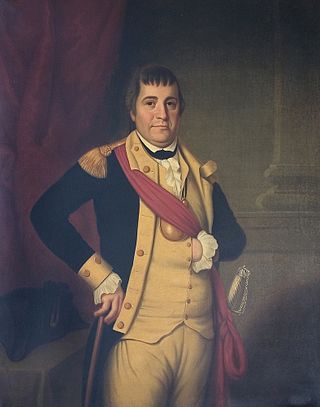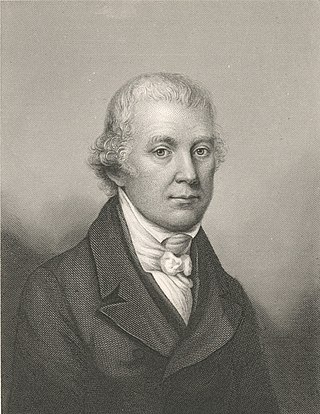Ezekiel Cornell was a Revolutionary War general who represented Rhode Island in the U.S. Continental Congress from 1780 to 1782.

James Mitchell Varnum was an American legislator, lawyer, general in the Continental Army, and a pioneer to the Ohio Country.
The 16th Massachusetts Regiment, also known as Henry Jackson's Additional Continental Regiment, was a unit of the American Massachusetts Line, raised on January 12, 1777, under Colonel Henry Jackson at Boston, Massachusetts. The regiment would see action at the Battle of Monmouth and the Battle of Rhode Island. The regiment was disbanded on January 1, 1781, at New Windsor, New York.

The 1st Rhode Island Regiment was a regiment in the Continental Army raised in Rhode Island during the American Revolutionary War (1775–83). It was one of the few units in the Continental Army to serve through the entire war, from the siege of Boston to the disbanding of the Continental Army on November 3, 1783.

The 2nd Rhode Island Regiment was authorized on 6 May 1775 under Colonel Daniel Hitchcock in the Rhode Island Army of Observation and was organized on 8 May 1775 as eight companies of volunteers from Providence County of the colony of Rhode Island. As part of a brigade organized under Nathanael Greene, the unit participated in the Siege of Boston during the remainder of 1775. Some elements accompanied Benedict Arnold's expedition to Quebec late in the year. The unit was renamed the 11th Continental Regiment on the first day of 1776.

The 9th Connecticut Regiment was a regiment of the Continental Army during the American Revolutionary War. It was first called Webb's Additional Continental Regiment before being added to the Connecticut Line in 1780. It saw action at Setauket in 1777, Rhode Island in 1778, and Springfield, New Jersey, in 1780, and was generally active in the defense of Connecticut, southern New York, and northern New Jersey. It was merged into the reorganized 2nd Connecticut Regiment in January 1781.

The Connecticut Line was a formation within the Continental Army. The term "Connecticut Line" referred to the quota of numbered infantry regiments assigned to Connecticut at various times by the Continental Congress, the size of its allocation determined by the size of its population relative to that of other states. These, together with similarly apportioned contingents from the other twelve states, formed the Continental Line. The concept was particularly important in relation to the promotion of commissioned officers. Officers of the Continental Army below the rank of brigadier general were ordinarily ineligible for promotion except in the line of their own state.

The Massachusetts Line was those units within the Continental Army that were assigned to Massachusetts at various times by the Continental Congress during the American Revolutionary War. These, together with similar contingents from the other twelve states, formed the Continental Line. Line regiments were assigned to a particular state, which was then financially responsible for the maintenance of the regiment. The concept of the line was also particularly important in relation to the promotion of commissioned officers. Officers of the Continental Army below the rank of brigadier general were ordinarily ineligible for promotion except in the line of their own state.

The Rhode Island Line was a formation within the Continental Army. The term "Rhode Island Line" referred to the quota of numbered infantry regiments assigned to Rhode Island at various times by the Continental Congress. These, together with similar contingents from the other twelve states, formed the Continental Line. The concept was particularly important in relation to the promotion of commissioned officers. Officers of the Continental Army below the rank of brigadier general were ordinarily ineligible for promotion except in the line of their own state.
Israel Angell was a Continental Army officer of the American Revolutionary War.

Jabez Bowen, Sr. was an American shipper, slave trader and politician. He was a militia colonel during the American Revolutionary War, and served as Deputy Governor of Rhode Island and chief justice of the Rhode Island Supreme Court.

William Barton (1748–1831) was an officer in the Continental Army during the American Revolutionary War who retired with the rank of colonel. He later served as adjutant general of the Rhode Island militia.

William Jones was the eighth Governor of Rhode Island from 1811 to 1817. He was a Federalist.

Associators were members of 17th- and 18th-century volunteer military associations in the British American thirteen colonies and British Colony of Canada. These were more commonly known as Maryland Protestant, Pennsylvania, and American Patriot and British Loyalist colonial militias. But unlike militias, the associator military volunteers were exempt from regular mandatory military service. Other names used to describe associators were "Associations", "Associated", "Refugees", "Volunteers", and "Partisans".

Samuel Ward Jr. was an American Revolutionary War soldier, politician, and delegate to the secessionist Hartford Convention.
Christopher Lippitt was a prominent Revolutionary War officer and founder one of the earliest textile mills in Rhode Island.
Colonel Henry Sherburne (1748-1824) was an officer in the Continental Army during the American Revolution. He commanded Sherburne's Additional Continental Regiment from 1777 to 1781 and served as the General Treasurer of Rhode Island from 1792 to 1807.
Church's Regiment was a unit of the Continental Army raised in Rhode Island which served from May 3, 1775 to December 31, 1775 in the American Revolutionary War.
Richmond's Regiment was a regiment formed by the state of Rhode Island in November 1775, during the American Revolution for the defense of the state against an attack by the British.
Babcock's/Lippitt's Regiment was a regiment raised for the defense of Rhode Island during the American Revolution.










